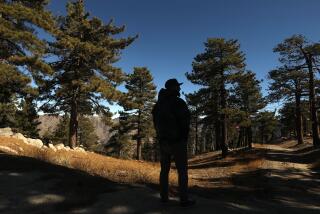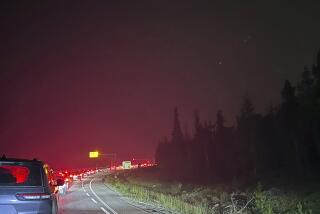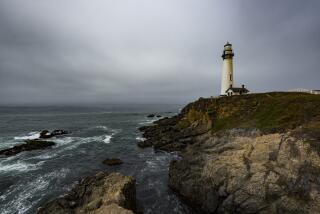Banffâs snowy serenity
Lake Louise, Canada â The ultimate in dark and stormy nights -- thatâs the thought I clung to as my flight landed in Calgary, Albertaâs gateway to the Banff-Lake Louise region. I could see little but a huge black sky as a shuttle took me through the city and toward my hotel.
Years before, I had been to these northern reaches of the Rocky Mountains, but it had been summertime, and Banff National Park was overflowing with tourists and campers, many of them children. The place seemed like a high-altitude theme park.
Now, in March, as falling snow greased the highway and my shuttle fishtailed, I wondered if winter was the wrong season to reacquaint myself with the âotherâ Rockies. Ralph, the driver, speed-dialed the police to ask where the snowplows were.
The car finally slid into the driveway of the venerable Fairmont Chateau Lake Louise. Eight stories high, almost foreboding in the dark, dormers laden with snow, the hotel looked like a fortress. Was my trip going to become a gothic novel? I snuggled into a big bed in a small room, hoping for the best.
The next morning, sunlight pierced a gap in the curtains. I pushed them aside and before me lay as perfect a winter landscape as I have seen. There was Lake Louise, blanketed in snow, framed by mountains whose stratified layers were outlined in white. A glacier cascaded through two peaks. The cerulean sky did not have a cloud in it. Perhaps my adventure was to be a magical Tolkien tale.
Although I had come to Banff for a week to ski its three alpine resorts -- Lake Louise, Sunshine and Norquay -- I decided the morning was made for a quiet, reflective introduction to the Canadian Rockies. So, rather than rush for the bus to the slopes, I made my way through the chateauâs grand lobby, which is topped by a huge chandelier of milkmaids holding the lighting torches, to the resortâs Nordic Stop, which rents cross-country skis.
I joined a touring group led by Dave Verhulst, a wholesome-faced 26-year-old instructor. We warmed up by skiing along practice trails in the nearby evergreen forest. The snow was feather light. Hotel guests who cross-country ski here, Verhulst said, include âa lot of boomers fed up with downhill, looking for something more serene.â
We glided on tracks across the lake, then delved into the woods, our skinny skis climbing just high enough to glimpse the sweeping scenery. It could not have been more serene.
The chateau commanded the head of the lake, its yellow roughcast stucco facade bathed in sunlight. The hotel was built in 1890 to house tourists brought by the Canadian Pacific Railroad, but it since has undergone numerous renovations. The current architecture dates from 1913, when the railwayâs architect, Walter Painter, designed towers, windows and terraces to reflect the Palladian villa designs of the Italian Renaissance, although the roof and dormered windows incorporate a more traditional French style. The hotel got a $65-million restoration and expansion in 1990.
The chateau has been a magnet for celebrities, and Banff has long been used as a film setting, from âEternal Loveâ with John Barrymore in 1929 to âRiver of No Returnâ with Marilyn Monroe in 1954.
Early on, it was strictly a summer place, not expanding to become a four-season resort until 1982. As our group skied past an immense ice sculpture outside the hotel and went inside for lunch at the casually elegant Fairview Dining Room, I pitied early tourists who never experienced this grand castle in its winter incarnation.
Sisters in the grande-dame mold
Later I checked out the chateauâs sister hotel, the 1888-built Fairmont Banff Springs, which straddles a hillside in the town of Banff. The hotel has 770 rooms, compared with the chateauâs 487.
Banff Springs resembles a Romanesque citadel with its dark redbrick front, turrets and a labyrinth of rounded archways on its lower shopping level. For me the biggest attraction was Solace, its spa, a fabulous indoor-outdoor complex that includes a gym, massage rooms, hot tubs and swimming pools. The best part: soaking pools fed by the hot springs from which the hotel got its name. After a day out in the cold, I felt deliciously decadent slipping into the waters.
The alpine skiing in the Banff region is on a similarly grand scale. Closest to the chateau is the Lake Louise resort, whose slopes you can see from the hotel. At 4,200 acres, it is larger than Mammoth Mountain, and its scenery rivals the beauty of Switzerland. Next in size is Sunshine Village, a 30-minute bus ride from Lake Louise or the town of Banff. Sunshine is actually three mountains connected by a gondola and other lifts; it gets the most snow. Norquay is the smallest and the oldest. The first ski hill was cut in 1926, though a lift was not erected until 1948.
Dates and statistics donât convey Banffâs atmosphere, which is more European than that of the American Rockies and yet is distinctly Canadian. All three ski areas and the town of Banff (population 7,600) are within Banff National Park, Canadaâs first. The government imposes strict limits on who can live here and what can be built. Youâll see no sprawl, no huge developments crawling up the mountains, no trophy homes. Most visitors stay in one of the hotels or motels, although condominium complexes also are present.
The ski resorts lack the on-slope accommodations and integrated villages of shops and restaurants that make places like British Columbiaâs Whistler more popular. Add the weather, which gets frosty, and one can understand why about 75% of the regionâs tourists visit in spring and summer.
But lower winter demand translates to lower prices, and the favorable exchange rate adds even more incentive for U.S. skiers to join weekenders from Calgary and visitors from Britain, who constitute Banffâs biggest market for longer stays.
The Canadian Rockies look and feel different. Mt. Rundle, its erosion-carved profile looking like a giant has taken a bite out of it, hovers over the compact little burg of Banff, bound by the Trans-Canada Highway on the north and the Bow River on the south. The altitude is less extreme than is typical of North Americaâs top ski resorts: Goatâs Eye Mountain at Sunshine is 9,200 feet, Mt. Whitehorn at Lake Louise only 8,765 -- so skiers get a Rocky Mountain high without the headache. Because the tree line also is lower, large swaths of the upper terrain consist of bare, open pistes like in the Alps.
Arriving by bus at the Lake Louise resort, I was amazed at the attractiveness and accessibility of its base area. Buses stop outside the Lodge of the Ten Peaks, a striking log building that houses a rental shop, cafeteria and bar. The base lifts are a short walk away.
On my first day, a âski friend,â as the local volunteers are called, showed a group of us around. With two high-speed quads, a double chair and a beginnersâ T-bar all climbing from the same base region, Lake Louise can guarantee waits of 10 minutes or less. In our case, we didnât wait at all.
The area is so immense that the intermediate and advanced skiers in my group spent two days on the slopes and still didnât investigate every run. (Smart skiers often target a particular chair to take several laps.) We headed through some easy bumps to the Larch chair area. Tree huggers glided through glades; the rest of us warmed up on green or blue cruisers. The Larch and Ptarmigan chairs share an entry area, so we tried steeper glades too.
Though it was not a powder day, snow was plentiful. The Banff ski areas usually enjoy a long season. This year Lake Louise opened Nov. 2 and Sunshine opened Nov. 17, and neither is scheduled to close until mid-May. Norquay is scheduled to open Friday.
By late morning, clouds were drifting in and visibility was supposedly poor around the region served by the Top of the World lift, especially Louiseâs vast back bowls and the super-expert Diamond Mine runs. Fat snowflakes were fluttering, and the temperature was dropping.
Although I didnât get too many views from the lifts, I did fall in love with, of all things, the bus ride from Banff to Lake Louise and Sunshine. The mountains cast their spell over the Trans-Canada Highway. I saw a touch of Coloradoâs Maroon Bells, a bit of New Zealand, a hint of the Alps in the landscape.
In fact, the ride to Norquay was a lot better than the skiing. Norquay has been luring snow lovers to its slopes longer than almost any other hill on the continent. Locals told me that an Austrian guide, Conrad Kain, introduced skiing in Banff in 1909. Early ski tourists must have been a hardy lot. Even in March, short runs were tough, and the weather made us feel as if we were inside a Sub-Zero freezer.
Then there was Sunshine -- fun despite wind-swept snow squalls and chilly temperatures. The area gets more snow than its neighbors but is oddly configured, requiring everyone to take a big gondola from a parking lot to the slopes. Skiers spread out over three mountains: Goatâs Eye, Lookout and Mt. Standish.
At the common base of the latter two lies Mad Trappers Saloon. Itâs a congenial old cabin with the right amount of rowdiness (especially when the lifts close) to go with the burgers, wings and pitchers of beer. Nearby is the rambling, newly renovated Sunshine Inn, the regionâs only ski-in, ski-out hotel.
During a break in the blowing snowfall, I realized that we were gliding across a huge, mostly tree-free bowl with sudden turns into precipitous chutes and near ladders. Anyone who loves the Big Burn at Snowmass would love the runs from the top of the Continental Divide express chair on Sunshineâs Lookout Mountain. The choice of itineraries is vast (wide or narrow, tough or easy, straight or crooked), and the thigh-burning runs can seem to go on forever.
During my two days at Sunshine, the resort delivered everything but its name. Better skiers than I spun thrilling tales of their adventures in Delirium Dive, a hair-raising plunge that requires a hike from the top of Lookout. Delirium divers must carry avalanche beacons and shovels. The run tests the nerve of the most fearless, although, according to a friend, itâs not as narrow as the chutes of New Mexicoâs Taos or Utahâs Alta.
As one exhausted skier remarked when we got back to Banff, âI skied Delirium once, and now I canât wait to go to sleep!â
Reminders of the Olympics
I also enjoyed my foray to Canmore, a world-class cross-country area just outside the national park. Canmoreâs stadium-like center oval was built for the 1988 Olympics, so, after a pleasant glide through forests and over frozen creeks, I could swoosh into the arena and imagine fans filling the seats, cheering and waving flags.
When not skiing or indulging in the spa, I strolled through Banff. Itâs a compact town with excellent restaurants and an international corps of tourists. The fine Whyte Museum has items from Canadian pioneer life along with interesting photography and cartography exhibits.
Thanks to the exchange rate, I was able to have a bison steak dinner for just $19 at the Maple Leaf Grill. Had I wanted to, I could have gotten a bargain on apparel too at the Roots shop, including the snazzy berets and other attire U.S. Olympians wore in Salt Lake City, making this Canadian line instantly chic.
Because I was attending a meeting at the Banff Centre, I took advantage of the institutionâs lovely campus on the edge of town, where artists, writers and people who contemplate cold climates for a living contribute to a lively intellectual scene.
Throughout the year the center hosts colloquia, film festivals, literary readings and musical programs. A group of colleagues and I enjoyed an evening of short, funny documentaries threaded with a mountain theme, as well as an evening with the author of books about trekking through the Himalayas.
On my final day, I skied Louise one last morning and then had lunch at Melissaâs, an unpretentious Lynx Street restaurant with great omelets. Had I not held a ticket for a flight out of Calgary that evening, nor been on a limited budget, I know what I would have preferred to do: board the next bus to the Chateau Lake Louise, find a nook under its eaves in which to hide and spend the remainder of the snow season as a stowaway.
*
Taking in the majesty of Banff
GETTING THERE:
From LAX, Air Canada flies nonstop, and United and America West offer connecting service (change of planes) to Calgary. Restricted round-trip fares start at $265.50.
WHERE TO SKI:
All prices are in U.S. dollars.
Alpine, snowboarding: Ski Banff-Lake Louise-Sunshine, Box 1085, Banff, Alberta, Canada T1L 1H9; (800) 661-1431 or (403) 762-4561, fax (403) 762-8185, www.skibanfflakelouise.com. Partnership of Banff National Parkâs three ski resorts. Three-day pass good at all three places costs $41 for children 6-12, $118 for ages 13-64 and $104 for 65 and older. Includes free shuttles from Banff and Lake Louise hotels.
Packages: Lodging packages may save money. Peak season example: three nights at the Fairmont Banff Springs Hotel and a three-day, all-resorts ski pass for $336 per person. A similar three-night package based at the Fairmont Chateau Lake Louise is $345 per person.
Cross-country: Canmore Nordic Centre, site of 1988 Winter Olympics Nordic events, (403) 678-2400, www.trailsports.ab.ca; and the Nordic Stop at Chateau Lake Louise, rentals and lessons, (403) 522-1898, Ext. 1201.
WHERE TO STAY:
Fairmont Chateau Lake Louise, 111 Lake Louise Drive, Lake Louise, Alberta T0L 1E0; information (403) 522-3511, toll-free reservations (800) 257-7544, fax (403) 522-3834, www.fairmont.com. A 487-room resort where I stayed. Standard rates for a double room start at $221 per night; ski package starts at $107 per person, per day.
Fairmont Banff Springs, 405 Spray Ave., Banff, Alberta T1L 1J4; information (403) 762-2211, reservations (800) 257-7544, fax (403) 762-5755, www.fairmont.com. Larger sister hotel of the chateau, with spa pools fed by hot springs. Doubles from about $155.
Other choices include the cosmopolitan Rimrock Resort Hotel outside the town of Banff, (800) 661-1587, www.rimrockresort.com; the Post Hotel, a rustic Relais & Chateaux property near Lake Louise, (800) 661-1586, www.posthotel.com; and the Sunshine Inn, which has mountainside rooms and two-bedroom suites, (877) 542-2633, www.banffreservations.com. Budget choices: the Banff Alpine Centre hostel, (866) 762-4122, www.hihostels.ca/hostels/Alberta/, and the Banff Voyager Inn, (403) 762-3301, www.banffvoyagerinn.com.
WHERE TO EAT:
The Maple Leaf, 137 Banff Ave., Banff; (403) 760-7680. Seafood, pastas, regional game specialties. Dinner entrees $15-$30.
Melissaâs, 218 Lynx St., Banff; (403) 762-5511. Casual steakhouse also serves seafood, pastas. Main courses $8-$15.
CONTACT:
Canadian Tourism Commission, 550 S. Hope St., 9th Floor, Los Angeles, CA 90071; (213) 346-2700, fax (213) 346-2785, www.canadatourism.com.
*
Grace Lichtenstein, who lives in New Mexico and New York, is the Southwest columnist for onthesnow.com.
More to Read
Sign up for The Wild
Weâll help you find the best places to hike, bike and run, as well as the perfect silent spots for meditation and yoga.
You may occasionally receive promotional content from the Los Angeles Times.






